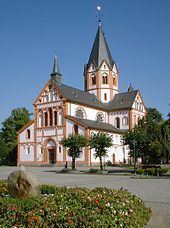District Ahrweiler Time zone CET/CEST (UTC+1/+2) Area 41.02 km² Local time Wednesday 9:08 PM | Elevation 90 m (300 ft) Postal codes 53489 Population 17,558 (31 Dec 2008) Postal code 53489 | |
 | ||
Weather 8°C, Wind SE at 8 km/h, 75% Humidity Points of interest Ahr, Heimatmuseum der Stadt Sinzig, Brücke über die Ahr‑Mündung | ||
Er ffnung festjahr 750 jahre stadtrechte sinzig
Sinzig is a town in the district of Ahrweiler, in Rhineland-Palatinate, Germany. It is situated on the river Rhine, about 5 km south-east of Remagen and 25 km south-east of Bonn, and it has approximately 20,000 inhabitants (2004).
Contents
- Er ffnung festjahr 750 jahre stadtrechte sinzig
- Map of 53489 Sinzig Germany
- Karnevalszug sinzig 2017
- History
- Sightseeing
- Municipal subdivisions
- Town song
- References
Map of 53489 Sinzig, Germany
Karnevalszug sinzig 2017
History
Sinzig received its first official recognition in 762 A.D. On 10 July that year, King Pippin the Younger, the father of Charlemagne, presented a certificate of his decree in the Palace of Sinzig (Sentiaco Palacio), officially recognizing the town as "Sentiacum." Sinzig first received its rights as a town on 9 October 1267.
Because of the influence Emperor Frederick Barbarossa had on the town, it is nicknamed a "Barbarossa town".
Twice, the medieval town, which since 1300 has been protected by a massive wall, was almost entirely destroyed by fires, one in 1583 and another in 1758. Little of the wall now remains, as industrialization and urban development led to its nearly complete loss at the end of the 19th century. After World War II, Sinzig experienced a population explosion and soon evolved into an industrial town.
With the district reform of 1969, Bad-Bodendorf, Franken, Koisdorf, Löhndorf, and Westum became provinces of Sinzig. Today, Sinzig, together with the town of Remagen, have developed a modern consumer centre, with multiple schools and shopping centres.
Sightseeing
There is no point in the "Golden Mile" where the defining icon of Sinzig, the parish church of Saint Peter, cannot be seen. The late Roman Basilica is one of the most meaningful pieces of Roman architecture, reason enough for the church to be added to the United Nations' list of "World Culture Heritage" artifacts.
The Sinziger Schloss (Sinzig Castle) was built in the period of the Rhine Romantic. Between 1854 and 1858, a businessman, Gustav Bunge of Cologne, ordered the erection of a summer villa in Sinzig in the style of a neo-gothic palace. Surrounding the palace is a garden, constructed in the style of a Romantic park. The castle has now been turned into a museum.
Also worth seeing:
